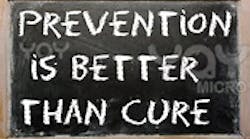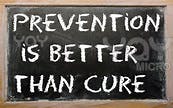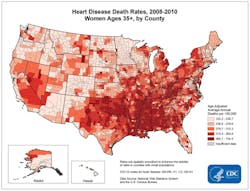Heart and cardiovascular disease is the number one killer of women and men, causing one in three deaths.1 It is well known that prevention can stop most deaths from cardiovascular and other diseases. So why do we have such high disease rates? Some say it could be the translation of research into clinical practice and consumer beliefs and life styles. This article will review prevention issues in health care.
Source: Centers for Disease Control and Prevention
I will discuss with you some of the messages some think should be shared and heeded. According to Greenland and Lloyd-Jones, “Heart attacks rarely occur in the absence of the major risk factors (adverse levels of blood cholesterol, blood pressure, smoking, diabetes).”2 Conversely, they say, “Absence of the major cardiovascular risk factors is highly protective against cardiovascular morbidity and mortality.”2
Experts believe that we can win the war against heart and cardiovascular diseases if we are straight and blunt with our prevention message, and encourage action around risk factors that are controllable. Age, genetics, and other factors are not changeable. But blood pressure, cholesterol, diabetes, obesity, and cigarette smoking are conditions and behaviors that can be controlled or managed in most cases.
The message should start with children. According to the Centers for Disease Control and Prevention (CDC): “childhood obesity has more than doubled in children and quadrupled in adolescents in the past 30 years.”3 Obesity raises the risk of diabetes, cardiovascular, heart, and many other diseases.
We know that awareness of any disease risk, including cardiovascular disease (CVD) risk, is associated with individuals taking preventive action. In a Circulation article titled, “Twelve-Year Follow-Up of American Women’s Awareness of Cardiovascular Disease Risk and Barriers to Heart Health,” the authors found that awareness of CVD as the leading cause of death among women has nearly doubled since 1997.4 However, that number is becoming constant instead of increasing, and there is a gap in awareness and mixed messages about prevention in racial and ethnic minorities.
Several misunderstandings and barriers to prevention continue to exist. According to the authors, “women strongly favored environmental approaches to facilitate preventive action.”4
Complicated decisions must sometimes be made in the area of prevention. An example from Michelle McDowell is that “We know that mammograms reduce the risk of dying from breast cancer; however, there is a chance of being referred for a biopsy that reveals the scan to be a false positive.”5 Berlin's Harding Center for Risk Literacy helps to outline the risk/benefit controversies.6 “Often health care providers focus only on the positives of screening,” says Michelle McDowell, a research fellow and leader of the project. “We're helping people weigh the benefits and harms.”5Click on this link to view chart. The chart appears a couple of paragraphs down into the article.
Multiple sclerosis (MS) is a disease that affects the brain and spinal cord and is the result of a dysregulated immune response. Women are three to four times more likely than men to develop MS.7 Many experts classify MS as an autoimmune disease; others do not. One study showed how certain cells show sex differences in their actions and can protect against autoimmune disease.7
Researchers are hoping they will find indications to clarify probable activators of these cells and whether those activators can be used in new treatments or pharmaceuticals. The conclusions could lead to a new method of designing pharmaceuticals that modulate the immune system of MS patients, instead of completely suppressing it, according to the authors. This may prevent drugs side effects, or lessen them, and may provide insight into other diseases that strike predominately women, such as autoimmune diseases.
In addition to increased morbidity and mortality, lack of prevention costs money. According to John Rice, vice chairman of General Electric (GE), the American Heart Association, and CDC, annual direct medical costs associated with cardiovascular diseases are expected to increase to more than $800 billion by 2030, while decreased productivity costs could exceed $275 billion.8
In developing markets, the rise of non-communicable diseases like heart disease is straining healthcare systems already in trouble, and placing large populations at risk.8 Rice discusses the power of partnerships, one of which is Million Hearts.9 Million Hearts’ goal is to prevent 1 million heart attacks by 2017. There are numerous resources, toolkits, action guides, treatment protocols, publications, and more to help with prevention efforts.
As oral health care professionals, let’s do what we can to increase access to health screening services, and refer individuals to primary care when appropriate. Take blood pressures and perform other risk assessments like oral cancer examinations in the office.
Partner with other groups in the community, whether for heart disease, oral cancer, or other types of prevention. Partnerships can help resolve many health challenges, increasing access affordable health care, decreasing the growth of non-communicable diseases, and creating better outcomes for individuals in need of assistance.8 Let’s try straight talk, and end the mixed messages about prevention.
References
- Women and Heart Disease Fact Sheet. http://www.cdc.gov/dhdsp/data_statistics/fact_sheets/fs_women_heart.htm.
- Greenland P, Lloyd-Jones D. Editorial. Time to End the Mixed—and Often Incorrect—Messages About Prevention and Treatment of Atherosclerotic Cardiovascular Disease. Journal of the American College of Cardiology, Vol. 50, No. 22, p 2133-2135, 2007.
- http://www.cdc.gov/HealthyYouth/obesity/facts.htm.
- Mosca L, Mochari-Greenberger H, Dolor RJ, et al. Twelve-Year Follow-Up of American Women’s Awareness of Cardiovascular Disease Risk and Barriers to Heart Health. Circulation: Cardiovascular Quality and Outcomes. 2010; 3: 120-127. Published online before print February 10, 2010, doi: 10.1161/CIRCOUTCOMES.109.915538.
- http://www.wired.com/2015/01/breast-cancer-detection-screening/.
- https://www.harding-center.mpg.de/en
- Russi AE, Walker-Caulfield ME, Ebel ME, Brown MA. Cutting Edge: c-Kit Signaling Differentially Regulates Type 2 Innate Lymphoid Cell Accumulation and Susceptibility to Central Nervous System Demyelination in Male and Female SJL Mice. The Journal of Immunology, 2015; DOI: 10.4049/%u200Bjimmunol.1500068.
- Rice J. How to tackle big health-care issues: GE exec. Yahoo Finance. http://finance.yahoo.com/news/tackle-big-health-care-issues-140701594.html;_ylt=AwrTceIuJItVzl8AIKknnIlQ;_ylu=X3oDMTE0Y21uNWhqBGNvbG8DZ3ExBHBvcwMxBHZ0aWQDRkZYVUkzNF8xBHNlYwNzYw--.
- http://millionhearts.hhs.gov/index.html.












